ENSAM Casablanca, Fs ben m'sik and MAMS Organize
2nd Seminar on Materials and Industrial Innovation
Starting in:
The second edition of the seminar aims to bring together researchers, engineers, healthcare professionals, and industry experts to explore the emerging synergies between materials science and artificial intelligence within the health sector. The event will highlight how intelligent materials, nanotechnology, and AI-driven modeling are transforming biomedical devices, diagnostics, and personalized medicine.






🧬 Presentations by industry partners and research scientists labs
➤ Latest advancements in materials science and artificial intelligence
➤ Real-world applications in biomedical devices, implants, and diagnostics
🧪 Industry & Research Showcase
➤ Presentations by industrial partners and research labs
➤ Case studies on AI-driven materials development and smart health technologies
🔬Oral presentations and a poster session by Ph.D. students, postdocs, and researchers
🧠 Expert Roundtable Discussions
➤ Topic : Contribution of AI in the design and optimization of new biomaterials.
🧫 Implement a training, support, monitoring, and advisory plan for our doctoral students and young doctors in the field of materials sciences.
🖐️ Hands-On Workshop
Table ronde
Faculty of Sciences Sidi Mohamed Ben Abdellah University Fez

Faculty of Sciences Sidi Mohamed Ben Abdellah University Fez
Le professeur Khalil Azzaoui est un chercheur éminent en chimie inorganique, affilié au Département de chimie de la Faculté des sciences de l'Université Sidi Mohamed Ben Abdellah (USMBA), à Fès, au Maroc. Titulaire d'un doctorat en chimie, il possède une vaste expertise dans divers domaines, notamment les minéraux, les composites, le phosphate, l'orthopédie, les biomatériaux, la chimie analytique, les nanoparticules, l'extraction, la caractérisation des matériaux, les nanomatériaux, les polymères et la durabilité du traitement des eaux usées. Tout au long de sa carrière, le professeur Azzaoui a publié 135 articles scientifiques, cumulant plus de 58 000 lectures et 1 498 citations, témoignant de l'impact significatif de ses travaux au sein de la communauté scientifique.
1Engineering Laboratory of Organometallic, Molecular Materials and Environment, Faculty of Sciences Dhar EL Mahraz, Sidi Mohamed Ben Abdellah University, P.O. Box 1796 (Atlas), 30000 Fez, Morocco.
2Euromed University of Fes, UEMF, Fes, Morocco.
Abstract In this study, an innovative methodology was implemented to combine an isoxazole derivative (ARZ) with hydroxyapatite (HAp), varying several parameters to obtain three distinct composites (ARZ-Hap-1, ARZ-Hap-2 and ARZ-Hap-3). These composites (ARZ-Hap) were synthesized by a dissolution-recrystallization process, thereby facilitating enhanced interaction between ARZ and HAp. This approach promoted homogeneous dispersion of ARZ within the HAp matrix, consequently enhancing the stability and functionality of the resulting materials. The structural characterization of these composites was determined by FT-IR, XRD, BET, TGA, and NMR (¹³C, ³¹P) methods. Subsequently, the composites were subjected to a rigorous evaluation process to ascertain their antibacterial and antifungal activities. Among them, the ARZ-Hap-3 demonstrated a significant degree of antimicrobial activity, surpassing that of established reference antibiotics when tested against E. coli, S. aureus, and B. subtilis. In terms of antifungal activity, this composite demonstrated the best results, particularly against C. albicans and F. oxysporum, with minimal MIC and MFC values comparable to those of fluconazole. These results indicate the potential of the ARZ-Hap-3 composite as a promising bioactive material, demonstrating a combination of structural efficiency and targeted biological activity. The release of ARZ from the composites was monitored by UV-Visible spectroscopy, revealing a gradual and controlled profile. The quantity of the substance released is proportional to the initial content of ARZ, with a maximum observed for ARZ-Hap-3 (~900 mg/L). This mechanism, based on slow diffusion, confirms the potential of these materials for sustained release of active ingredients. Furthermore, a molecular docking analysis was conducted to explore potential interactions between ARZ and biological targets associated with the pathogens studied. The results of the study indicated a high binding affinity of ARZ with certain enzymes that are essential for bacterial and fungal survival. This finding corroborates the experimental observations made in the study, thereby providing a scientific rationale for the observed effects. Keywords: isoxazole, 1,3-dipolar cycloaddition, hydroxyapatite, antibacterial, antifungal, good health and well-being, medical innovation, Health promotion, public health.Universitat Politècnica de València, UPV

Universitat Politècnica de València, UPV
Faculté de médecine Dentaire – Université Mohammed VI des Sciences de la Santé.

Faculté de médecine Dentaire – Université Mohammed VI des Sciences de la Santé.
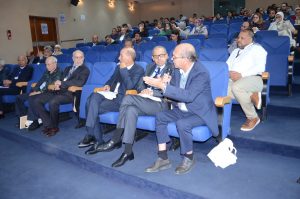
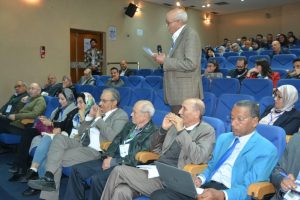
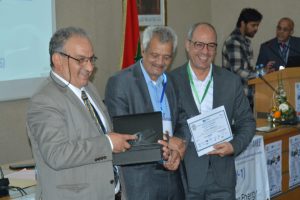
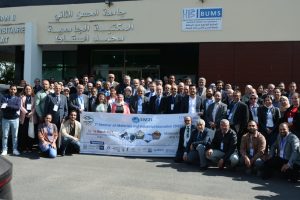

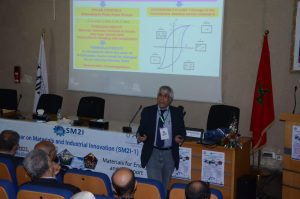

150 Bd du Nil, Casablanca 20670
Phone +212 52 25 64 222
Email contact@ensam-casa.ma
11 – 12 DECEMBER 2025
09H00
150 Bd du Nil, Casablanca 20670